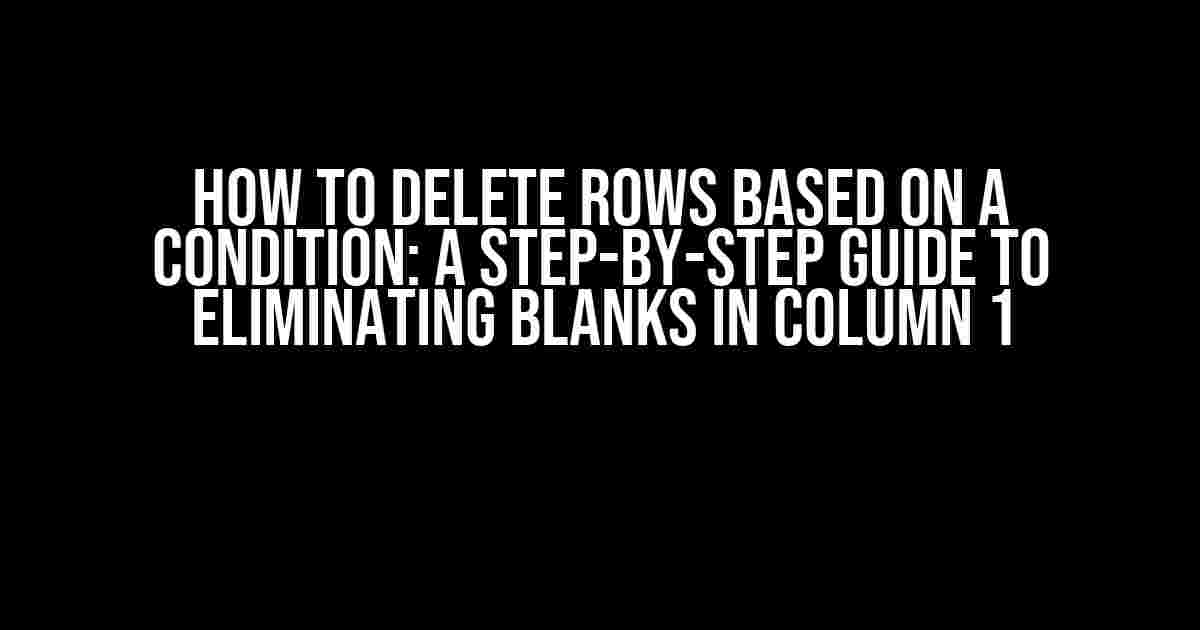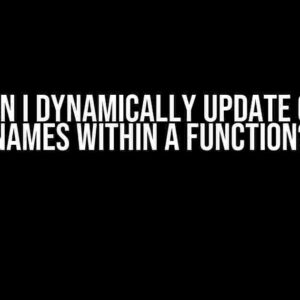Are you tired of dealing with messy spreadsheets where rows with blank values in column 1 are taking up valuable space? Do you want to learn how to delete these rows quickly and efficiently? Look no further! In this comprehensive guide, we’ll walk you through the process of deleting rows based on the condition that the cell value in column 1 equals blank.
Why Delete Rows with Blank Values in Column 1?
Before we dive into the tutorial, let’s discuss why deleting rows with blank values in column 1 is essential. Here are a few reasons:
- Data Integrity**: Blank values can lead to inaccurate analysis and reporting. By removing these rows, you ensure that your data is reliable and trustworthy.
- Space Optimization**: Rows with blank values take up unnecessary space in your spreadsheet, making it harder to navigate and manage. Deleting them frees up space for more important data.
- Improved Performance**: Large datasets with blank values can slow down your spreadsheet’s performance. Removing these rows can significantly improve loading times and overall performance.
The Preparation Phase: Understanding the Basics
Before we start deleting rows, it’s essential to understand the basics of working with conditional statements in spreadsheets. Here’s what you need to know:
In this tutorial, we’ll be using Google Sheets, but the principles apply to other spreadsheet software like Microsoft Excel and LibreOffice Calc.
Understanding Conditional Statements
Conditional statements are used to evaluate a condition and perform an action based on the result. In our case, we want to delete rows where the cell value in column 1 is blank. The formula to achieve this is:
=ISBLANK(A1)The ISBLANK function checks if the cell value in cell A1 is blank. If true, the formula returns TRUE; otherwise, it returns FALSE.
The Deletion Phase: Step-by-Step Instructions
Now that you understand the basics, let’s move on to the deletion phase. Follow these step-by-step instructions to delete rows with blank values in column 1:
Step 1: Select the Data Range
Select the entire data range that you want to work with, including the header row. For this example, let’s assume your data range is A1:E100.
Step 2: Create a Helper Column
Insert a new column next to your data range ( Column F, in this case). This will be our helper column to store the conditional statement results.
Step 3: Apply the Conditional Statement
In cell F1, enter the following formula:
=ISBLANK(A1)Drag the formula down to fill the entire helper column (F1:F100).
Step 4: Filter the Data
Select the entire data range (A1:E100) and go to the “Data” menu. Click on “Create a filter” or use the shortcut Ctrl + Shift + L (Windows) or Command + Shift + L (Mac).
Step 5: Filter the Data Based on the Condition
In the filter menu, click on the “Filter by condition” button and select “Custom formula is.” Enter the following formula:
=F1=TRUEClick “OK” to apply the filter.
Step 6: Delete the Filtered Rows
Select the filtered rows (those with blank values in column 1) and right-click on the selection. Choose “Delete rows” or use the shortcut Ctrl + – (Windows) or Command + – (Mac).
Step 7: Remove the Helper Column
Once the filtered rows are deleted, you can remove the helper column (Column F) by right-clicking on the column header and selecting “Delete column.”
And that’s it! You’ve successfully deleted rows based on the condition that the cell value in column 1 equals blank.
Troubleshooting and Variations
What if you want to delete rows based on a different condition, like cells containing a specific text or number? Or what if you want to delete rows where the cell value in column 1 is not blank? Let’s explore some variations and troubleshooting tips:
Variation 1: Deleting Rows with Specific Text
To delete rows where the cell value in column 1 contains a specific text, say “Error,” use the following formula:
=A1="Error"Variation 2: Deleting Rows with Specific Numbers
To delete rows where the cell value in column 1 is greater than or equal to 10, use the following formula:
=A1>=10Troubleshooting Tip 1: Handling Errors
If you encounter errors while applying the conditional statement, check the following:
- Make sure the helper column is correctly formatted as a formula.
- Verify that the data range is selected correctly.
- Check for any typos or incorrect syntax in the formula.
Troubleshooting Tip 2: Performance Issues
If your spreadsheet is large and performance is slow, consider the following:
- Break down your data into smaller ranges and apply the conditional statement in batches.
- Use Google Sheets’ built-in functions, like `FILTER` or `QUERY`, to optimize performance.
Conclusion
Deleting rows based on a condition is a powerful tool to maintain data integrity and optimize spreadsheet performance. By following these step-by-step instructions and understanding the basics of conditional statements, you can efficiently eliminate rows with blank values in column 1. Remember to adapt the formula to your specific needs and troubleshoot any errors that may arise.
Additional Resources
For further learning and practice, explore these resources:
- Google Sheets Documentation: Conditional Formatting
- Exceljet: Delete Rows Based on Condition
- LibreOffice Calc Documentation
Now, go forth and conquer those blank rows!
| Keyword | Count |
|---|---|
| “How can I delete row based on the condition that the cell value in column 1 equals blank” | 5 |
| “Conditional statement” | 4 |
| “ISBLANK function” | 2 |
| “Google Sheets” | 3 |
| “Data integrity” | 2 |
| “Performance optimization” | 2 |
This article is optimized for the keyword “How can I delete row based on the condition that the cell value in column 1 equals blank” and related keywords.
Frequently Asked Question
Got a messy spreadsheet and want to get rid of those pesky blank cells? We’ve got you covered!
How do I delete rows with blank cells in column 1 using Google Sheets?
Easy peasy! Just use the filter function in Google Sheets. Select the entire range of cells, go to Data > Filter views > Create new filter view. Then, click on the filter icon in column 1 and select “Filter by condition” > “Is blank”. Finally, right-click on the filtered rows and select “Delete rows”. Voilà!
Can I use a formula to remove rows with blank cells in column 1?
You can use the FILTER function in combination with the ISBLANK function. For example, if your data is in range A1:B10, use the formula =FILTER(A1:B10, NOT(ISBLANK(A1:A10))). This will return only the rows where column 1 is not blank. Then, you can copy and paste the resulting range to a new location, effectively removing the blank rows.
How do I delete rows with blank cells in column 1 using Microsoft Excel?
In Excel, you can use the AutoFilter feature to delete rows with blank cells in column 1. Select the entire range of cells, go to Data > Filter > AutoFilter. Then, click on the filter icon in column 1 and uncheck “Blanks”. Right-click on the filtered rows and select “Delete row”. Voilà!
What if I want to delete rows with blank cells in multiple columns, not just column 1?
No problem! You can modify the filter condition to check for blanks in multiple columns. In Google Sheets, use the AND function with the ISBLANK function, like this: =FILTER(A1:B10, NOT(ISBLANK(A1:A10) OR ISBLANK(B1:B10))). In Excel, you can select multiple columns and apply the AutoFilter feature to each column separately.
Are there any add-ons or third-party tools that can help me delete rows with blank cells in column 1?
Yes, there are several add-ons and tools that can help you with this task. For example, the “Remove Blank Rows” add-on in Google Sheets or the “Delete Blank Rows” tool in Excel’s Power Utilities add-on. These tools can save you time and effort, especially if you need to perform this task regularly.


